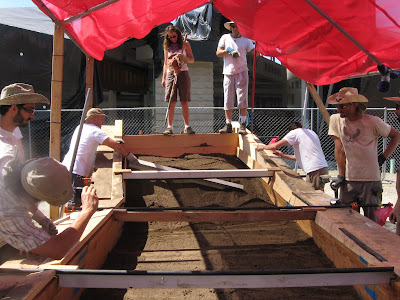mixing: pre-sifted soil, cement, and water. We mixed partly by hand but mostly with a rototiller. Percentage of cement for this project ranged from %6-20. To check if there is enough water in the mix, form a ball of soil, drop it from about five feet: if it shatters completely, the moisture content is correct. However, it was so hot and dry, that we needed to add more water to compensate for the moisture that would evaporate during transport and ramming.
wheeling: find Sonia!
raking: distributing the soil mix evenly in the formwork
screeding: levelling the soil mix
ramming: we used manual (not electric) rammers, long metal poles with a small metal square at the end. The small surface area increases the pressure per square inch. It took a lot of strength to repeat this motion. Ramming decreases the soil volume to %60 of the original, and results in a very durable material. We added soil and rammed in layers or "lifts," I think there were 4-5 lifts total. These layers will likely be visible in the finished product, similar to the layers of sedimentary rock. In fact, some people described this process as turning soil back into rock.
Tuesday, August 21, 2012
Subscribe to:
Post Comments (Atom)





No comments:
Post a Comment